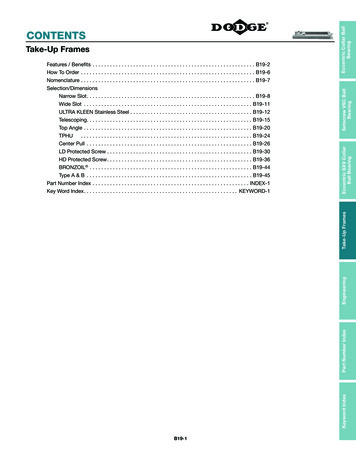Simulation Of Passive Magnetic Bearing Using COMSOL .
Excerpt from the Proceedings of the 2011 COMSOL Conference in StuttgartSimulation of Passive Magnetic Bearingusing COMSOL MultiphysicsKrzysztof FalkowskiMilitary University of Technology*Corresponding author: Kaliskiego 2, 00-908 Warsaw, Poland, krzysztof.falkowski@wat.edu.plAbstract: The article presents the process ofverification of the passive magnetic bearing bythe Comsol Multiphysics program. There isshown construction of the radial passivemagnetic bearing PMB60x85x20-5, which wasdesigned in the Military University ofTechnology. The distribution of the magneticflux density and the static characteristic of thebearing were estimated by using ComsolMultiphysics. The stiffness coefficient wasobtained from the static characteristic.The author shows fundamental laws ofmagnetism and presents magnets for the radial,axial passive magnetic bearing and radialpassive magnetic bearing with Halbach’sarray.Keywords: permanentbearing, rotor.magnet,magnetic1. IntroductionThe magnetic bearings are used in differentapplication, where the elimination of thefriction is necessary. They are applied in themachine tool with high speed rotors, in theengine turbine, in the fly wheel energy storage,etc. Additionally, the magnetic bearings canwork in the aggressive atmosphere (liquefiedoxygen and methane, etc.), sea water andvacuum. The magnetic suspend system of rotoreliminates system of cooling and lubrication.Therefore, the magnetic bearing ensuresincrease reliability and efficiency of the turbomachines.These bearings divide into active magneticbearing and passive magnetic bearing. Theactive magnetic bearing (AMB) uses thefeedback loop between position of rotor in theair gap and the magnetic force. There consistsof rotor position sensor in the air gap, thesystem of automatic control position of rotor inthe air gap, the power amplifiers andelectromagnetic actuators. The active magneticsystem ensures high precision location of rotorin the air gap, but this system is the mostexpensive solution.The passive magnetic bearing (PMB) hasnot feedback loop as the active magneticbearing. The position of rotor is superpositionof the magnetic repelling forces and externalforces [2, 3]. It does not ensure high precisionlocation of the rotor. There is steady stateerror, which is proportional to external forces.However the passive magnetic bearing hasmeaningful advantage, it is cheaper solutioncompared with the active magnetic bearing [1,2, 3].The passive magnetic bearings are builtfrom the permanent magnets. They make useof repelling or attractive magnetic forcesbetween magnets to magnetic levitation. Therepelling forces are used in a large majority ofapplication. The configuration of the passivemagnetic bearing with attractive magneticforces menaces loss of magnetic levitation [3,4].The design of the passive magnetic bearingis very difficult. The magnets generate nouniform magnetic field. The value anddirection is different in the space around themagnets. The electrotechnics method (Ohm’sand Kirchhoff’s laws) is unhelpful for designthe passive magnetic bearings. Only the finiteelements method is useful for design andverification project of passive magneticbearing.The author uses the loop with molecularcurrent as a mathematical model of passivemagnetic bearing. The finite elements methodis used to verification this model.2. Construction of passive magnetic bearingThe passive magnetic bearing was builtfrom the magnets or assembly magnets withdifferentorientationofvectorofmagnetization. The magnets with the radialorientation of vector of magnetization are usedby the radial passive magnetic bearing (theradial forces of capacity) and the magnets withthe axial orientation of vector of magnetizationare used by the axial passive magnetic bearing(the axial forces of capacity). The radialpassive magnetic bearing with the Halbach’sarray uses radial and axial magnets. The arrayof magnets generates strong field in theselected space around the magnets. Th
magnetism and presents magnets for the radial, axial passive magnetic bearing and radial passive magnetic bearing with Halbach’s array. Keywords: permanent magnet, magnetic bearing, rotor. 1. Introduction The magnetic bearings are used in different application, where the eliminat
cooper bearing craft du bearing dual vee economy bushing edt elges fag bearing federal bronze fk bearing frantz bearing fyh bearing general bearing ggb bearing tech graphalloy hepco hiwin hub city hudson bearing hyatt
True bearing is the angle measured relative to the true north line (see Figure 4). The starting point to determine true bearing is the nortsouth line. North will then always be 0º. True bearing is always measured clockwise from north at 0º. FFFFIIGGUURREE IGURE 444 True bearing, magnetic bearing and magnetic declination 2.2.2 Magnetic bearing
feedback controller regulating its position. These bearings are called active magnetic bearings (AMB). Another kind of magnetic bearing on the market is the permanent magnetic bearing (PMB) existing of permanent magnets. Permanent magnetic bearing have the possibility to be
the bearing. Active Magnetic bearing is a contactless bearing technology that aims to eliminate the drawbacks of roller bearings as well as journal bearings. Active Magnetic bearing is based on fundamentals of electromagnetic levitation through attractive forces. The load bearing rotor is suspended at the center of the stator.
Magnetic stir bar, Ø 3x6 mm A00001062 Magnetic stir bar, Ø 4.5x12 mm A00001063 Magnetic stir bar, Ø 6x20 mm A00001057 Magnetic stir bar, Ø 6x35 mm A00001056 Magnetic stir bar, Ø 8x40 mm A00000356 Magnetic stir bar, Ø 10x60 mm A00001061 Magnetic cross shape stir bar, Ø 10x5 mm A00000336 Magnetic cross shape stir bar, Ø 20x8 mm A00000352
contents 1. bearing failure analysis 3 1.1 determination of operating data 3 1.2 lubricant sampling 4 1.3 inspection of the bearing environment 4 1.4 assessment of bearing in mounted condition 5 1.5 dismounting the damaged bearing 5 1.6 assessment of the complete bearing 5 1.7 assessment of bearing components
SXV and SXR Ball Bearing Take-Up Bearing from 3/4” through 2-7/16” shaft size. DL Ball Bearing Take-Up Bearing from 3/4” through 1-7/16” shaft size. LT700 and LT1000 SOLlDLUBE Take-Up Bearing from 3/4” through 2-1/2” shaft size. Six sizes of Wide Slot Ball Bearing
realizes a functional behavior of a logic system from a given description (stated in form of verbal statements, truth table, K-map, state diagram, etc.) Example : Synthesize a logic function that realizes the following truth table. Use AND, OR, and NOT gates Figure 2.15. A function to be synthesized. Chapter 2-14 Synthesis of digital circuits f (a) Canonical sum-of-products f (b) Minimal-cost .






















